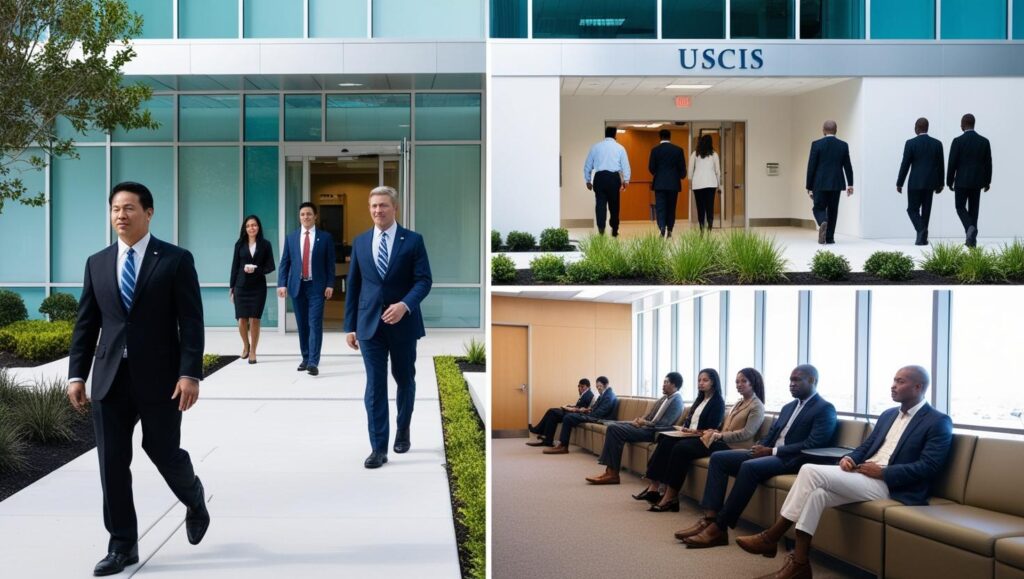The EB-1A visa is one of the most sought-after immigration pathways for individuals with extraordinary abilities in their field. Officially categorized as a first preference employment-based visa, the EB-1A allows highly accomplished individuals to self-petition for a green card without requiring a job offer or labor certification. This makes it an attractive option for those who have risen to the very top of their profession and wish to live and work permanently in the U.S.
In this guide, we’ll break down the self-petition process for the EB-1A visa, including eligibility requirements, the steps involved, and tips for building a strong case. Whether you’re a scientist, artist, athlete, or entrepreneur, this guide will help you navigate the green card process with confidence.
What Is the EB-1A Visa?
The EB-1A visa is designed for individuals who can demonstrate extraordinary ability in the sciences, arts, education, business, or athletics. To qualify, you must show that your achievements have been recognized at a national or international level and that you are among the small percentage of people who have risen to the very top of your field.
Unlike other employment-based visas, the EB-1A allows for self-petitioning, meaning you don’t need an employer to sponsor you. This is particularly beneficial for individuals who want to maintain independence in their career or who may not have a job offer in the U.S. at the time of application.
Eligibility Requirements for the EB-1A Visa
To qualify for the EB-1A visa, you must meet one of the following two criteria:
- Evidence of a One-Time Achievement
This refers to a major, internationally recognized award, such as a Nobel Prize, Pulitzer Prize, or an Olympic gold medal. If you have received such an award, you automatically meet the eligibility requirements for the EB-1A visa. - Meeting 3 of the 10 Evidentiary Criteria
If you haven’t won a one-time achievement, you can still qualify by meeting at least three of the following ten criteria:- Receipt of lesser nationally or internationally recognized prizes or awards for excellence in your field.
- Membership in associations that require outstanding achievement of their members.
- Published material about you in professional or major trade publications or other major media.
- Evidence of your participation as a judge of the work of others in your field.
- Evidence of original scientific, artistic, or business-related contributions of major significance to your field.
- Authorship of scholarly articles in professional journals or other major media.
- Display of your work at artistic exhibitions or showcases.
- Evidence of a leading or critical role for organizations or establishments that have a distinguished reputation.
- Evidence of a high salary or other significantly high remuneration compared to others in your field.
- Evidence of commercial success in the performing arts, as shown by box office receipts or record sales.
If you meet at least three of these criteria, you may be eligible to file an EB1A petition. However, it’s important to note that simply meeting the criteria is not enough—you must also demonstrate that your achievements have had a major impact and that your work will benefit the United States.

The Self-Petition Process for the EB-1A Visa
The self-petition process for the EB-1A visa involves several steps, from gathering evidence to filing the necessary forms with USCIS. Here’s a step-by-step breakdown:
Step 1: Gather Evidence of Extraordinary Ability
The first step in the process is to collect evidence that demonstrates your extraordinary ability and meets the eligibility criteria. This may include:
- Copies of awards, certificates, or honors you’ve received.
- Articles or media coverage about your work.
- Letters of recommendation from experts in your field.
- Documentation of your contributions to your field, such as patents, publications, or artistic works.
It’s crucial to organize your evidence in a way that clearly shows how you meet the visa requirements and how your achievements have been recognized nationally or internationally.
Step 2: File Form I-140, Immigrant Petition for Alien Workers
The next step is to file Form I-140, Immigrant Petition for Alien Workers, with USCIS. This form serves as your official petition for the EB-1A visa. Since the EB-1A allows for self-petitioning, you can file the form on your own behalf without needing an employer to sponsor you.
When filing Form I-140, you’ll need to include:
- Evidence of your extraordinary ability (as outlined in Step 1).
- A detailed cover letter explaining how you meet the eligibility criteria.
- Filing fees (check the USCIS website for the most up-to-date fee information).
Step 3: Consider Premium Processing
If you’re in a hurry to get a decision on your petition, you can opt for premium processing, which guarantees a response from USCIS within 15 calendar days. While this doesn’t guarantee approval, it can significantly speed up the process.
Step 4: Wait for USCIS Decision
Once you’ve submitted your petition, USCIS will review your case and determine whether you meet the eligibility requirements for the EB-1A visa. If your petition is approved, you can proceed to the next step in the green card process.
Tips for Building a Strong EB-1A Case
The EB-1A visa is highly competitive, and even small mistakes can lead to a denial of your petition. Here are some tips to strengthen your case:
- Focus on Quality Over Quantity
When submitting evidence, prioritize quality over quantity. For example, a few strong letters of recommendation from well-known experts in your field will carry more weight than a large number of generic letters. - Highlight Major Achievements
Be sure to emphasize your most significant accomplishments, such as internationally recognized awards, original contributions, or leadership roles. Use clear and concise language to explain why these achievements are important. - Work with an Immigration Attorney
While the EB-1A allows for self-petitioning, working with an experienced immigration attorney can help you navigate the process and avoid common pitfalls. An attorney can also help you craft a compelling narrative for your case. - Provide Comparable Evidence
If you don’t meet one of the standard criteria, you may be able to provide comparable evidence to demonstrate your extraordinary ability. For example, if your field doesn’t have traditional awards, you can provide evidence of other forms of recognition. - Be Prepared for a Request for Evidence (RFE)
USCIS may issue an RFE if they need additional information to make a decision on your petition. If this happens, respond promptly and provide the requested evidence in a clear and organized manner.
EB-1A Visa Guide: Self Petition Process for USCIS Green Card Approval (Part 2)
In the first part of this guide, we explored the eligibility requirements and the self-petition process for the EB-1A visa. Now, let’s dive into what happens after your petition is approved, the adjustment of status process, and how to avoid common mistakes that could delay or jeopardize your green card application.

What Happens After Your EB-1A Petition Is Approved?
Once USCIS approves your Form I-140, Immigrant Petition for Alien Workers, you can move on to the next step in the green card process. This step depends on whether you are currently in the U.S. or outside the country.
Adjustment of Status (If You Are in the U.S.)
If you are already in the U.S. on a valid nonimmigrant visa, you can apply for adjustment of status to become a lawful permanent resident. This process involves filing Form I-485, Application to Register Permanent Residence or Adjust Status, with USCIS.
Here’s what you’ll need to do:
- File Form I-485: Submit this form along with supporting documents, such as proof of your approved I-140 petition, evidence of lawful entry into the U.S., and your medical examination results (Form I-693).
- Attend Biometrics Appointment: USCIS will schedule a biometrics appointment to collect your fingerprints, photo, and signature.
- Wait for Approval: Once your application is approved, you’ll receive your green card in the mail, officially granting you lawful permanent resident status.
Consular Processing (If You Are Outside the U.S.)
If you are outside the U.S., you’ll need to go through consular processing to obtain an immigrant visa. This involves applying at a U.S. embassy or consulate in your home country.
Here’s how the process works:
- Submit Form DS-260: Complete the online immigrant visa application (Form DS-260) and pay the required fees.
- Attend a Medical Exam: You’ll need to undergo a medical examination by an approved physician.
- Attend an Interview: The U.S. embassy or consulate will schedule an interview to review your case and verify your eligibility.
- Receive Your Visa: If your application is approved, you’ll receive an immigrant visa, which allows you to travel to the U.S. and obtain your green card upon arrival.
Common Challenges and How to Overcome Them
The EB-1A visa process is complex, and even highly qualified applicants can face challenges along the way. Here are some common issues and tips for overcoming them:
1. Request for Evidence (RFE)
USCIS may issue an RFE if they need additional information to evaluate your petition. This is not uncommon, especially for EB-1A cases, where the burden of proof is high.
How to Handle It:
- Respond promptly and thoroughly to the RFE.
- Provide clear and organized evidence that directly addresses the issues raised by USCIS.
- Consider consulting an immigration attorney to ensure your response is strong and complete.
2. Denial of Petition
If your petition is denied, it can be disheartening, but it’s not necessarily the end of the road. USCIS will provide a detailed explanation of the reasons for the denial.
How to Handle It:
- Review the denial notice carefully to understand the specific issues.
- If the denial was due to insufficient evidence, you may be able to refile your petition with additional documentation.
- In some cases, you may be able to appeal the decision or file a motion to reopen or reconsider.
3. Delays in Processing
Immigration cases can take time, and delays are not uncommon, especially if USCIS is experiencing a high volume of applications.
How to Handle It:
- Check the visa bulletin regularly to monitor the status of your case.
- If your case is outside the normal processing time, you can submit an inquiry to USCIS or contact the National Visa Center (NVC) for updates.
- Consider premium processing for faster adjudication of your I-140 petition.

Maintaining Your Green Card After Approval
Once you’ve successfully obtained your green card, it’s important to understand your responsibilities as a lawful permanent resident. Here are some key points to keep in mind:
1. Renewing Your Green Card
Green cards are typically valid for 10 years. If your card is about to expire, you’ll need to file Form I-90, Application to Replace Permanent Resident Card, to renew it. Start the renewal process at least six months before your card expires to avoid any gaps in your status.
2. Traveling Outside the U.S.
As a green card holder, you can travel outside the U.S., but there are some restrictions. If you plan to stay outside the U.S. for more than six months, you may need to apply for a reentry permit to maintain your permanent resident status.
3. Applying for U.S. Citizenship
After holding a green card for five years (or three years if married to a U.S. citizen), you may be eligible to apply for U.S. citizenship. Becoming a citizen offers additional benefits, such as the right to vote and protection from deportation.
Tips for a Successful EB-1A Application
The EB-1A visa is one of the most prestigious immigration categories, but it’s also one of the most challenging to qualify for. Here are some final tips to help you succeed:
- Be Thorough: Provide detailed and well-organized evidence to support your case. USCIS officers are looking for clear and compelling documentation of your extraordinary ability.
- Stay Updated: Immigration laws and policies can change, so it’s important to stay informed about the latest requirements and guidelines.
- Seek Professional Help: While the EB-1A allows for self-petitioning, working with an experienced immigration attorney can significantly improve your chances of success.
- Be Patient: The visa process can be lengthy, but staying organized and proactive will help you navigate it more smoothly.
Final Thoughts on the EB-1A Visa
The EB-1A visa is a powerful tool for individuals with extraordinary abilities to achieve their dream of living and working in the United States. By understanding the eligibility requirements, following the self-petition process, and avoiding common pitfalls, you can increase your chances of success. What’s more, Green Card For Alien can help you with all the letter drafting required for EB1A.
Whether you’re a scientist making groundbreaking discoveries, an artist creating works of major significance, or an entrepreneur driving innovation, the EB-1A visa offers a pathway to permanent residency for those who have truly risen to the top of their field. With careful preparation and determination, you can turn your achievements into a new chapter of opportunity in the U.S.
Good luck on your journey to obtaining an EB-1A visa and achieving your goals in the United States!

